article
How to write an effective product launch email
The process of building a new product or feature starts with the initial spark of an idea, followed by diligent validation, creative design, meticulous engineering, as well as detailed testing. All these steps take a concept from thought to reality. However, the journey doesn’t end there. In reality, it’s just the beginning; the next challenge lies in introducing your innovation and finding customer adoption.
This is where product launch strategies come into play. From social media and blogging to paid advertising and PR, the digital marketing landscape has no shortage of channels to communicate product news to current and potential customers. But amidst this broad marketing spectrum, email marketing continues to hold a special place. The personalized communication and segmentation potential of email offers an unmatched advantage to companies; a 2022 report found that for every dollar spent on email, companies in the software and technology industry see a return of $36.
A well-crafted product launch email can be a powerful tool in your company’s marketing arsenal, making customers aware of your products and driving revenue growth through customer acquisition. In this article, we’ll explore the ideal timing, structure, and content of a compelling product launch email, share some email launch templates you can use, and examine successful real-world examples and why they work.
What is a product launch email?
A product launch email is a targeted and strategic communication intended to announce the introduction of a new product or feature to an existing customer base, potential customers, and/or other stakeholders.
Product launch emails are often sent out on a launch day. However, they can also be dispatched pre-launch to build anticipation or post-launch to sustain momentum and further encourage adoption. Taken together, they form a product launch email sequence.
The importance of product launch emails
The purpose of a product launch email is two-fold.
For your business, product launch emails offer the benefit of engaging your customer base, generating buzz, driving website or product traffic, creating a greater sense of brand familiarity, and ultimately influencing user conversion and retention rates.
For your customer, launch emails bring the benefit of keeping them informed about the latest additions to your product suite that might positively impact them or their business. They serve to outline the unique value proposition of your product, shed light on how these updates can solve their problems, and add value to their overall experience.
How to write a product launch email
Writing a successful product launch announcement that hits the mark requires thoughtful consideration and careful attention to several key elements. An uninspired product launch email may fall flat, failing to incite excitement or generate traction for your new product range or feature. This is a missed opportunity.
However, with strategic structuring and a few important inclusions—like visually appealing graphics and a good email subject line—your email can stand out in an inbox and make your launch day (and beyond) a success.
1. Consider a product launch email sequence
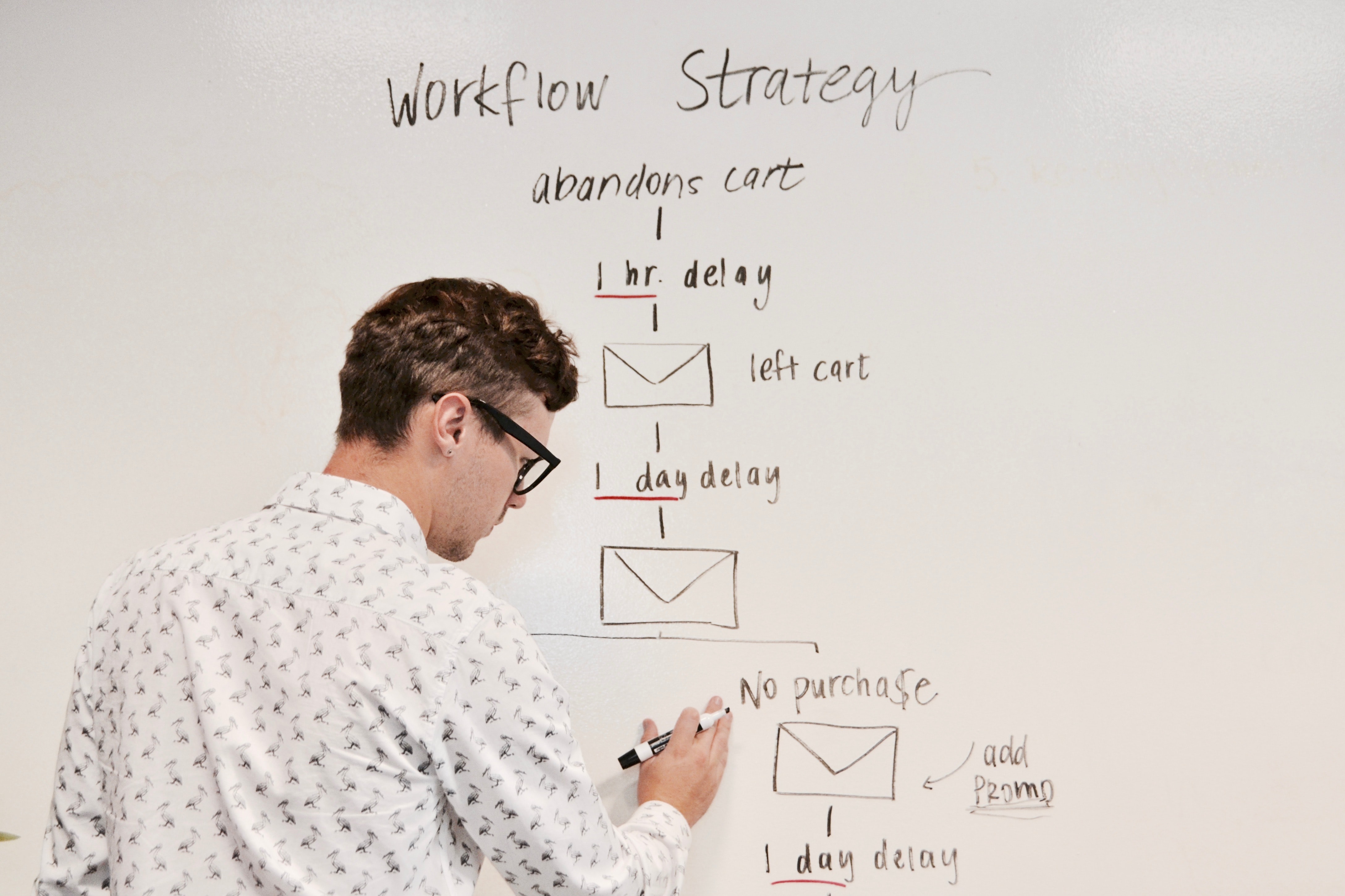
An effective product launch strategy often involves more than just a single product launch email on release day. Instead, by creating a sequence of product launch emails, you can strategically nurture excitement from your customer base, provide valuable information, and reinforce your product message at key stages in the product launch process.
Here are three types of emails to include in your product launch email campaign:
- Pre-launch product launch email. These should ideally be sent a few weeks prior to your product release. Its primary goal is to generate excitement, intrigue your email audience, and create anticipation about your upcoming offering. This email might include a sneak-peak or a teaser of what’s to come or offer early access to select customers, sometimes marketed as beta access. If you have a physical product, it might serve as a pre-order email.
- Release day product launch email. This email is sent on the day that your product or brand-new feature goes live. This email should express that your product launches today and focus on relevant details, benefits, and value propositions of your new product, encouraging your audience to try it out for themselves.
- Post-release product launch email. A post-launch email is generally sent out about a week after launch. This sendout can help solidify interest, answer common questions you’ve received, share positive reviews, or offer support for users getting started with your new product line.
As you consider your own product launch emails, remember to strike a communication balance. An overzealous email campaign might overwhelm your audience, so keep your communication succinct, engaging, and purposeful. Each email in your launch sequence should offer fresh, valuable content compared to the previous email, keeping your audience eager for what’s next.
2. Craft an attention-grabbing subject line
The email subject line is the first thing your audience sees and plays a sizable part in determining whether your email is opened or archived. Here are a few tips for creating a compelling subject line:
- Convey value quickly. Clearly highlight the unique value or benefit of your new product (e.g. “Streamline your CMS contacts in seconds with AutoSort”).
- Create curiosity. Intrigue your audience with a statement that makes them feel compelled to click (e.g. “Data cleaning features almost too good to be true”).
- Keep it brief. A shorter subject line is typically more impactful, especially on mobile. Try to keep it under 50 characters (e.g. “Dark Mode has landed for Lyrist”).
- Use action verbs and power words. Start with a dynamic action verb that grabs attention (e.g. Experience less downtime and quicker loading”).
- Use numbers or statistics. Numbers stand out in a sea of texts providing a quick snapshot of your message (e.g. “Boost team productivity by 50% with Focus Mode”).
- Add urgency. Mention that your product or feature launches today or next week (e.g. “Today we’re announcing Cascade!”).
3. Keep your messaging clear and concise

Your audience likely receives endless emails each day. A lengthy and convoluted message may get lost in the shuffle. Ensure your new product or feature announcement gets the attention it deserves, by following this advice:
- State your purpose up front. Begin your product launch email by immediately stating the purpose—the launch of your new product or feature. Your readers should know why they’re receiving the email within the first few seconds of reading.
- Focus on key features. Highlight the most important features and benefits of your new product, providing a brief overview. Avoid getting in the weeds with overly complex explanations.
- Use bullet points or subheadings. Break up text into digestible chunks, making it easier and skim.
- Use simple language. Write in plain and easy-to-understand language whenever possible. Skip the jargon.
- Have a clear call-to-action (CTA). Make it apparent what you want the reader to do next—whether that’s visiting your website, signing up for a trial, or watching a product demo.
- Be concise. Aim to convey your message in the fewest words possible. Cut out any unnecessary information or fluff.
4. Include eye-catching graphics and gifs
Vibrant graphics and gifs can amplify the impact of your own product launch emails. Consider incorporating a high-quality product image or gif, demonstrating the functionality of your new feature. These visuals provide immediate context about what’s new in your product and how it works, reducing the amount of text you need in your email overall. The aim is not to simply make your email more visually appealing but rather to reinforce your message and make it more digestible.
Try out custom graphics that convey your brand personality, while also emphasizing key selling points and illustrating the benefits of your new product. Or, opt for animated gifs to add an element of excitement to your email. Ensure your graphics or gifs support and enhance your message, without overwhelming your reader or slowing down email load times.
5. Include testimonials and social proof

Including praise about your product from real customers can significantly boost credibility and promote user confidence. In your product launch email, weave these testimonials and pieces of social proof into your overarching narrative.
They can reinforce key points and provide persuasive real-world evidence of your product’s benefits, transforming your product launch emails from a simple product launch announcement into a trust-building communication tool. Here’s how to gather and use these endorsements effectively:
- Ask early beta users. For a new product or feature, consider opening it up to a select group of customers beforehand. Ask for their feedback and permission to share their positive experiences.
- Rely on existing customers. If your latest feature builds on existing offerings, reach out to satisfied customers. Zero in on any impressive statistics or quantifiable results linked to your new product.
- Network with industry experts. Seek out thought leaders in your field who have tried your product, using social listening tools to find product mentions across platforms like Twitter or LinkedIn. Their endorsement could lend significant weight to your product launch.
6. Highlight the value proposition of your product
When introducing a new product or feature, your focus shouldn’t just be on the specific technical specifications or functionalities. There’s a difference between what should appear on a product manager’s spec and a customer email. Your customers care less about these details and more about the answer to one question: “How does this benefit me?”
Rather than talking about the product’s features in isolation, connect them to the benefits they provide. Ask yourself what customers love and need. Does your new software streamline workflow and save time? Does it provide powerful analytics that can drive decision-making for company leaders? Does it enhance collaboration or secure sensitive data? Articulating these benefits directly addresses the needs and pain points of your customers, while simultaneously positioning your features against competitors.
Here are examples of converting features into customer benefits in your email marketing:
-
265-bit encryption --> Enhance data security by creating virtually impenetrable protection for your sensitive business data
-
Bidirectional real-time data syncing --> Keep all your devices up-to-date by mirroring changes across platforms instantly
-
AI-powered predictive analytics --> Make informed business decisions by getting insights into future trends from your existing data
7. Include a clear call-to-action (CTA)

An effective product launch email must include a clear call-to-action (CTA), a directive guiding your email subscribers toward their next step. An unambiguous and compelling CTA can drive momentum for your launch, nudging customers toward exploring your new product or feature further. Your CTA should encourage user action and increase engagement, ultimately driving forward your launch goals.
Here are a few common product launch email CTAs:
- Learn How [new feature] Can Transform Your Business
- Upgrade to [new feature] Today
- Explore [new feature] Now
- Start Your Free Trial
- Schedule a Demo With Us
8. Consider the timing of your feature announcement
Timing is a crucial yet often overlooked aspect of a product launch email. Think beyond just your launch date, ensuring that your announcement arrives to inboxes at the right moment can affect its reception and impact. Here are some essential timing considerations:
- Product readiness. Before announcing, ensure the new product or feature is completely developed, tested, and ready for a seamless user experience. An ill-timed email about a buggy product or feature can negatively impact your company’s reputation.
- Industry events and announcements. Be aware of significant industry events or competitor product launches. If your announcement coincides with these, it may get overshadowed.
- Time of week and day. A 2022 survey from Brevo suggests that software or SaaS companies see the best results by sending emails on Tuesdays or Thursdays from 2:00 PM-3:00 PM. However, experiment with different send-outs over time to determine what is true of your audience. While you may have an international customer base, consider the time of day and week for where most of your customers are based.
9. Aim for audience segmentation and customization

When it comes to product launch emails, a one-size-fits-all approach can fall flat. A study from Mailchimp on email marketing found that segmented campaigns saw 14.31% higher opens and 100.95% more clicks than non-segmented campaigns. Email segmentation, coupled with personalization can significantly boost the effectiveness of your product launch email.
For instance, the CTO of a company might be interested in different product aspects compared to an end user. By tailoring your message to different user segments, you can make your email more relevant. Use email marketing software or a marketing automation platform that allows for easy personalization and segmentation.
10. Link out to additional information
A sendout is often the start of a conversation, not the end. A product launch email should serve as an engaging introduction to your new feature. However, it might not be the place to delve into every technical detail or use case. Including links to additional information lets current or prospective customers dive deeper. Here’s where to dive into more detail:
- Product landing page. A well-designed landing page, focused on your new feature, provides a destination for browsers to find more information on specific, use cases, or deeper benefits.
- Product demo video. Link out to product videos, tutorials, or recorded webinars that explain complex features.
- Blog post. If you’ve penned an in-depth blog post or help center article related to the new product feature, highlight and link within your product launch email.
- Contact info. If you’re a B2B or enterprise-level solution, providing an email or phone number for sales can be an effective strategy.
3 types of product launch email templates
Given these best practices, crafting effective product launch emails can be a daunting task. To assist your email marketing strategy, here are a set of email templates to optimize every touchpoint in your product launch sequence. Adapt these templates to suit your own product as you build anticipation, deliver a compelling announcement, and keep the conversation going post-launch.
Product launch teaser email template
Target Audience: All subscribers
Subject Line: Sneak Peek: Exciting New [Product] Coming Soon from [Company]
Email Body:
Hi [Name],
Get ready to meet [Product], a solution designed with your needs in mind. While we can’t reveal all the details just yet, we promise it’s going to revolutionize the way you [Customer Benefit].
Stay tuned for our official announcement. In the meantime, we invite you to visit our teaser page for a sneak peek into what’s coming [Link].
Get excited!
Best, [Your Name]
Product launch email template
Target Audience: All subscribers
Subject Line: Introducing [Product]: [Customer Benefit] Reimagined!
Email Body:
Hello [Name],
Today is the day! We’re thrilled to announce that [Product] is officially here.
[Product] is more than just a new product. It’s our answer to [Customer Benefit]. [Briefly describe the product or feature and its benefits in two or three sentences.]
Discover more about [Product] and how it can transform your work on our website [Link].
Don’t miss out on experiencing what [Product] can do for you!
Cheers, [Your Name]
Product post-launch email template
Target Audience: All subscribers
Subject Line: [Product] is Making Waves: See What You’re Missing Out On!
Email body:
Hello [Name],
It’s been a week since we launched [Product], and the response has been phenomenal.
In case you haven’t checked it out, here’s a quick recap of what [Product] can do for you: [Description].
Also, here’s what customers are saying about [Product]: [Social Proof]
Visit our website [Link] to explore [Product] in detail and see how it can [Customer Benefit].
Join the wave of users benefiting from [Product] today!
Best, [Your Name]
6 product launch email examples
To understand the practical application of these product launch email best practices, nothing is more insightful than real-life examples of email marketing. These examples illustrate how to capture the reader’s attention, engage readers, and generate excitement around upcoming features or a new version of your product.
1. Email example: Notion AI
Subject Line: Notion AI is now available to everyone
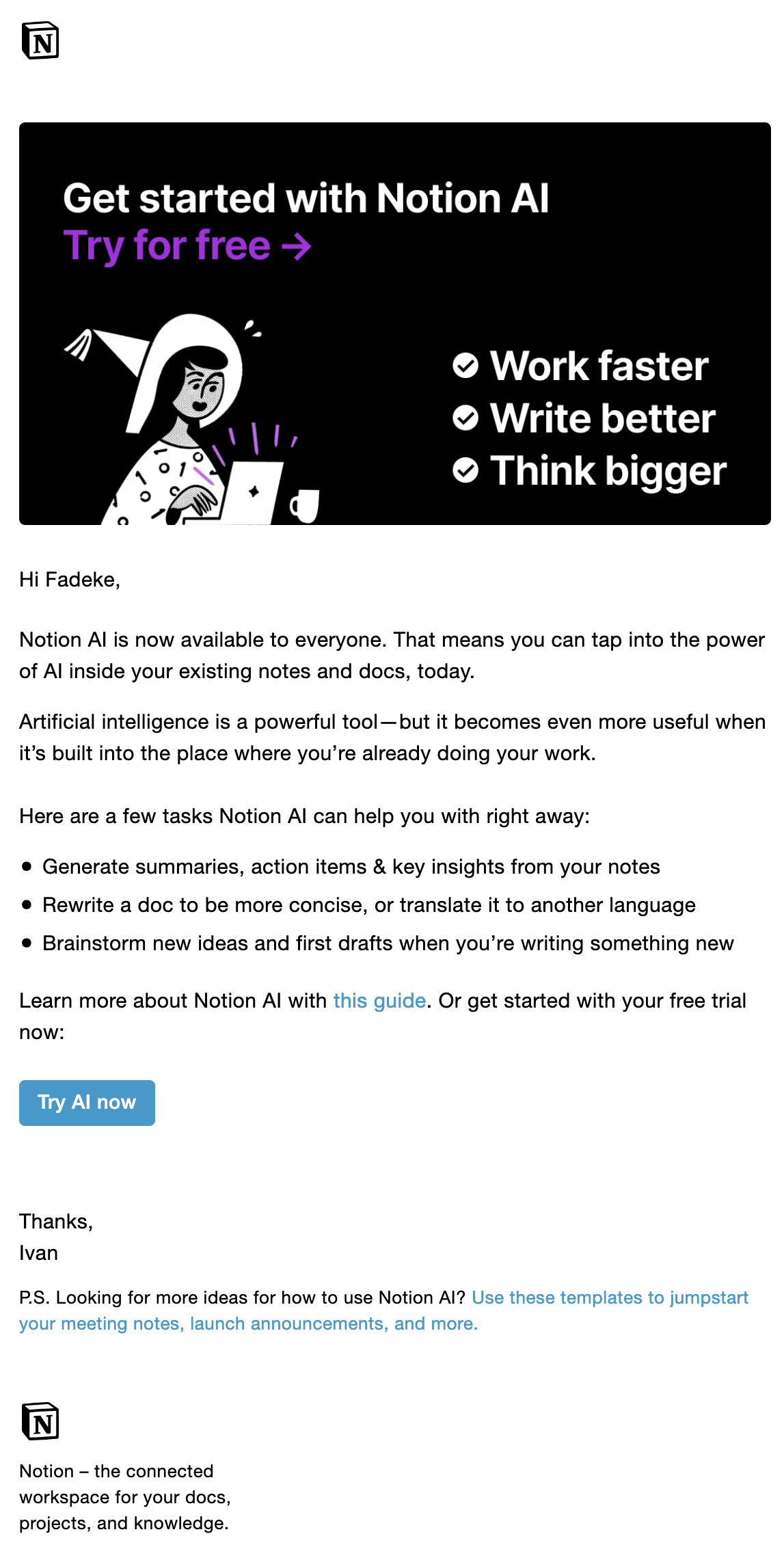
Here’s what they got right:
- Notion keeps their email short and succinct. They employ a branded infographic for readers to quickly glean the benefits of their release, and use a short bulleted list further down to convey use cases to customers.
- They link out to a more thorough guide on their release, as well as templates, rather than including every detail in the email.
- The company has a standout CTA at the bottom of the email, encouraging more users to try their latest AI product.
2. Email example: DigitalOcean

Here’s what they got right:
- The product launch email uses strategic formatting to break communication into sections, making key points stand out.
- DigitalOcean links out to more in-depth resources about Premium CPU-Optiized Droplets, rather than overwhelming readers with detail.
- The email clearly conveys the value that users will experience from the new product, emphasizing the improvement of core business operations.
3. Email example: Airtable
Subject Line: New: Streamline work faster, together with List View
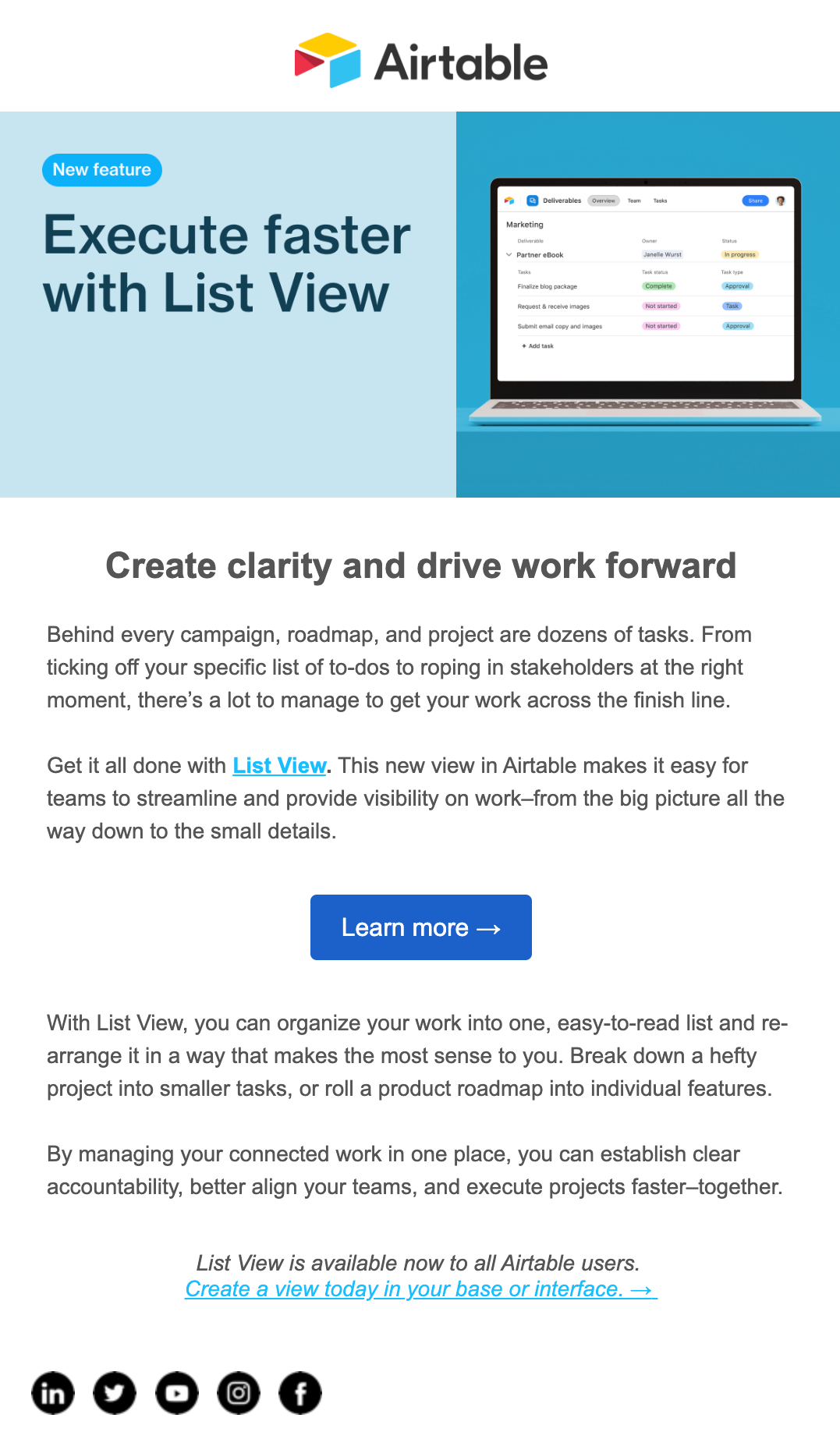
Here’s what they got right:
- The email subject line is short, but quickly conveys a clear benefit and mentions the name of the new feature.
- Airtable links out to a more comprehensive blog post on List View, mentioning only essential information within the email.
- The email effectively conveys the benefit of the feature to the customer, defining specific use cases and outlining positive team impacts.
4. Email example: Descript
Subject Line: Descript Season 4: New AI features & an overdue update
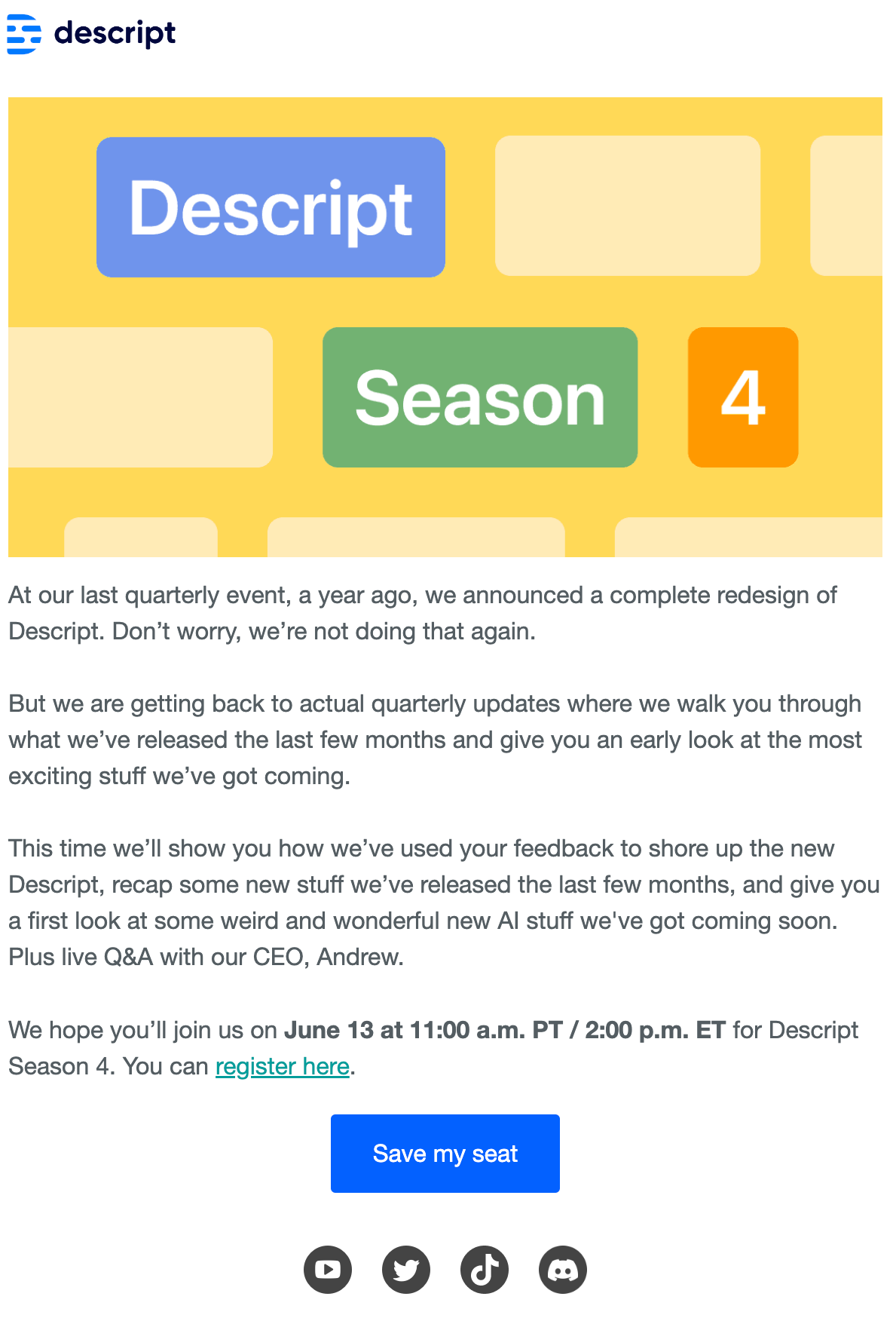
Here’s what they got right:
- Descript’s pre-launch product email teases upcoming releases, building excitement for what’s to come.
- The subject line is to the point, while also building intrigue around their upcoming AI offering.
- The email has a clear call to action, guiding readers to join a live Q&A to learn more about forthcoming features.
5. Email example: Clay
Subject Line: Thank You.
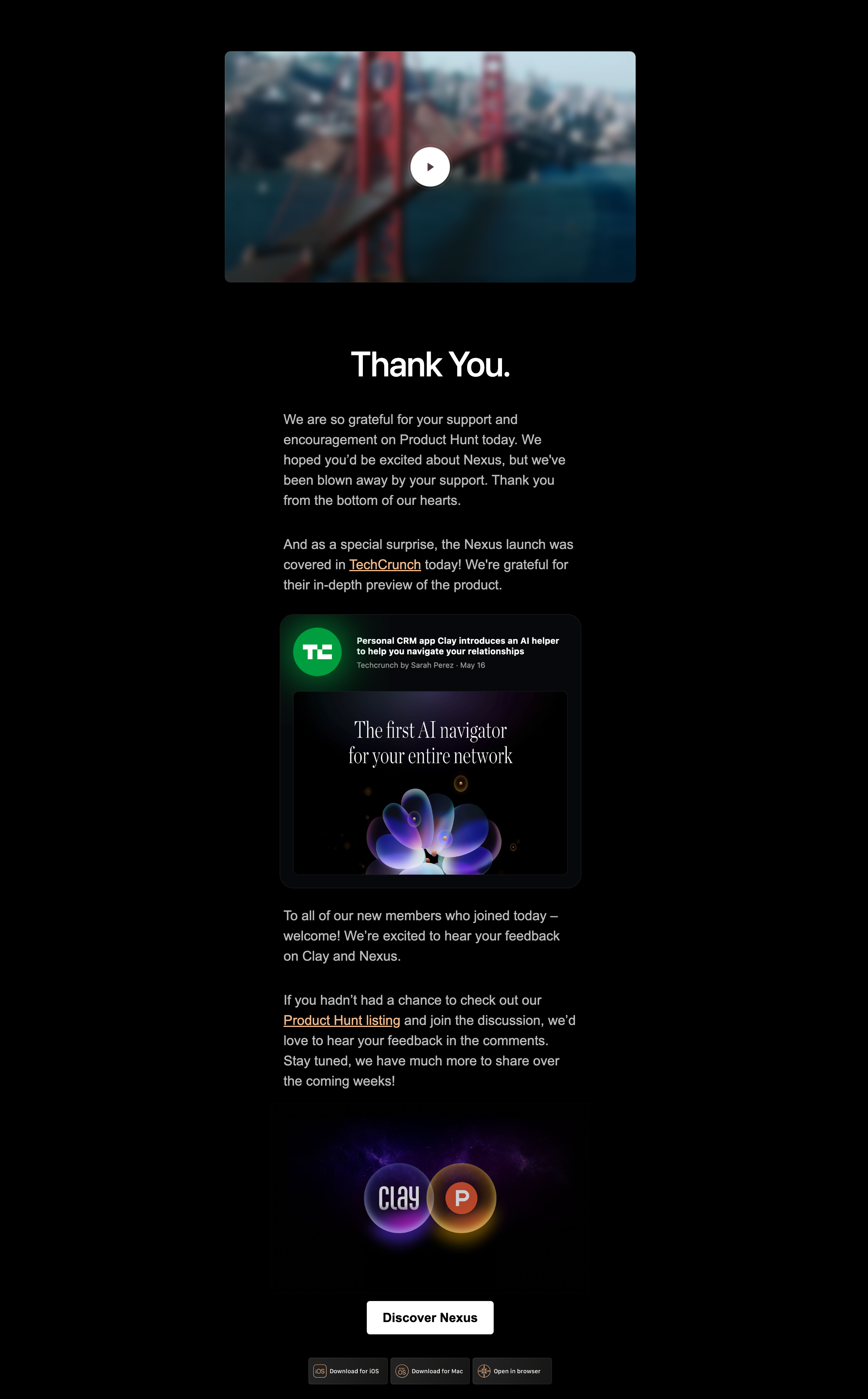
Here’s what they got right:
- This post-launch product email from Clay thanks customers for their support on the release, also using the communication as an opportunity to solicit feedback.
- The email links to an explainer video, giving readers a chance to visually explore the product release.
- Clay leverages social proof within the email, linking to prominent press coverage that adds credibility to their release.
6. Email example: Squarespace
Subject Line: Your free link in bio is waiting

Here’s what they got right:
- The subject line elicits a sense of urgency, compelling customers to open the email.
- The Squarespace product launch announcement email embeds a dynamic gif within the email, quickly providing subscribers with a visual preview.
- The email uses bolded headings to break up the text and clearly convey the most important information about the release.
As we’ve explored, a well-crafted product launch email can be the catalyst that transforms a new product release from a mere announcement into a moment of genuine excitement and engagement. By incorporating these strategic considerations, you’re poised to create a powerful narrative around your next tech product launch, captivating your audience and driving adoption.
Grow Your Company with DigitalOcean
Elevate your marketing tactics with DigitalOcean’s powerful tools. Leverage Droplets to power your analytics and Spaces for storing your marketing assets.
Start building today
Sign up now and you'll be up and running on DigitalOcean in just minutes.
Get started for free
Enter your email to get $200 in credit for your first 60 days with DigitalOcean.
New accounts only. By submitting your email you agree to our Privacy Policy.
Get started for free
Enter your email to get $200 in credit for your first 60 days with DigitalOcean.
New accounts only. By submitting your email you agree to our Privacy Policy.